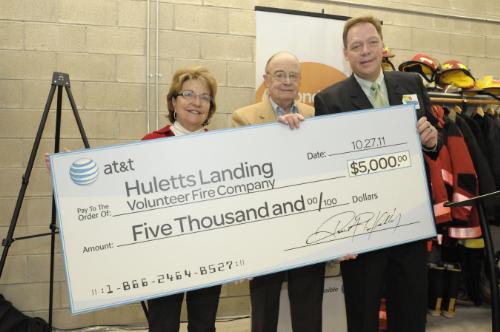
NY State Senator Betty Little (R) Queensbury and Huletts Landing Volunteer Fire Company President Arthur Borin accept $5,000 contribution from Robert Holliday, VP/GM AT&T Upstate NY. AT&T today held a community event in Huletts Landing outlining recent mobile broadband wireless coverage enhancements. (PRNewsFoto/AT&T Inc., Eric Jenks)
HULETTS LANDING, N.Y., Oct. 27, 2011 /PRNewswire/ — As part of its continuing network investment to support growing demand for advanced mobile devices and applications in New York State, AT&T today announced the activation of eight new cell sites and mobile broadband enhancements in Adirondack Park that will expand coverage for area residents and businesses and enable mobile broadband speeds.
“Expanding and enhancing New York’s mobile broadband network brings home the benefits of broadband access to many consumers in the Adirondacks who are relying more and more on wireless technology to access the Internet,” said State Senator Betty Little, (R) Queensbury, speaking at a community event at the Huletts Landing Volunteer Fire Company in Huletts Landing. “This kind of investment is critical to keeping New York competitive.”
In addition to providing the best mobile broadband experience, AT&T today presented Huletts Landing Volunteer Fire Company with a contribution of $5,000.00 as part of the company’s commitment to the local community. “Your business is very important to us, but just as important to us are the communities where we live and work everyday,” said Robert Holliday, vice president and general manager Upstate New York, AT&T. “Adirondack Park is a critical part of the Empire State and AT&T will continue to look for new opportunities in the region to be a good neighbor and to provide enhanced wireless services and products as a way to help drive the local economy.”
“Before AT&T made the network improvements, this area of the Adirondacks had little or no cellular service which created concerns from a convenience and safety standpoint,” said Arthur Borin, President Huletts Landing Volunteer Fire Company. “AT&T’s commitment to the network in our area has been a huge boost for local residents, our economy and tourists visiting the region year-round. We commend AT&T for their commitment to improving life and safety in the Adirondacks.”
With mobile broadband speeds, AT&T customers can surf the Web, download files faster, and enjoy the very latest interactive mobile applications. New areas of mobile broadband coverage for AT&T customers in the Adirondacks include:
Bolton: covering the I-87 Northway near Exit 24 in Warren County.
Caroga Lake/Canada Lake: along Routes 10 and 29A in areas of Fulton County.
Hague: on Route 9 and the northern end of Lake George in Warren County.
Huletts Landing: the northern shore of Lake George, Route 9 in Warren County and Routes 6, 6A and 6B in Washington County.
Johnsburg: along Route 28 in Warren County.
Northville: including Great Sacandaga Lake in Fulton County.
I-87 Northway: between Exits 25 – 26 (Pottersville-South Horicon) in Warren County.
Pilot Knob: serving Fort Ann, the eastern shores of Lake George in Washington County.
Mobile broadband enhancements in the Park were also made in areas of Lake Placid, Lyons Falls, Mineville (Belfry Mountain), Nicholville, North Elba, Old Forge, Port Henry/Moriah, Rattlesnake Mountain, Saranac Lake, and Whiteface Mountain.
The new cell sites are part of AT&T’s ongoing efforts to drive investment and innovation to deliver the nation’s best, most advanced mobile broadband experience. With the nation’s fastest mobile broadband network, AT&T provides accelerated mobile data speeds and simultaneous voice and data capabilities.
AT&T invested more than $200 million in its New York wireless and wireline networks in the first half of 2011. “We’re working to bring wireless coverage to rural areas like Adirondack Park throughout New York State,” said Amy Hines Kramer, regional vice president of external affairs for AT&T in New York. “In addition, our recently announced agreement to acquire T-Mobile USA represents a major commitment to strengthen and expand our network. If approved, this deal means that we’ll be able to expand the next generation of mobile broadband – 4G LTE – from our current plan of 80 percent of the U.S. population to more than 97 percent.”
AT&T’s mobile broadband network is based on the 3rd Generation Partnership Project (3GPP) family of technologies that includes GSM and UMTS, the most widely used wireless network platforms in the world. AT&T has the broadest international coverage of any U.S. wireless provider, providing access to voice service in more than 225 countries and data service in more than 200 countries. AT&T also offers voice and data roaming coverage on more than 135 major cruise ships, as well as mobile broadband services in more than 130 countries.
AT&T also operates the nation’s largest Wi-Fi network** with more than 29,000 hotspots in the U.S. and provides access to nearly 190,000 hotspots globally through roaming agreements. Most AT&T smartphone customers get access to our entire national Wi-Fi network at no additional cost, and Wi-Fi usage doesn’t count against customers’ monthly wireless data plans.
 The Lake George Land Conservancy has announced the hiring of Chad Knisely as the Land Conservancy’s new Land Protection and Stewardship Specialist.
The Lake George Land Conservancy has announced the hiring of Chad Knisely as the Land Conservancy’s new Land Protection and Stewardship Specialist.









